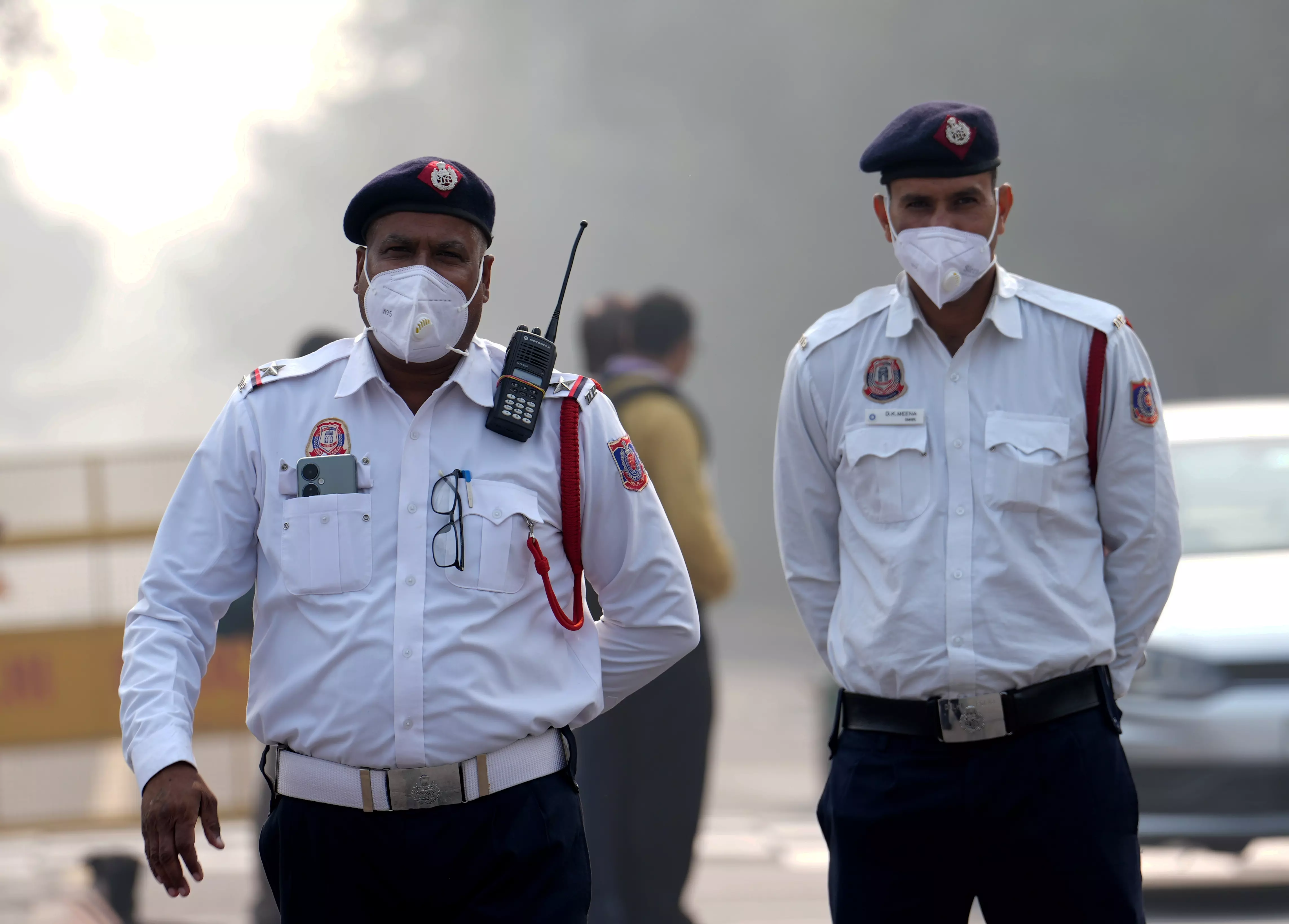
File photo of traffic cops in Delhi wearing mask amidst an increase in air pollution. PTI Photo
Pollution in Indian cities worsen: Air quality ‘severe’ in Delhi, ‘poor’ in Kolkata
An AQI between 201 and 300 causes health alert, and over 300 triggers health warnings of emergency conditions, said a pollution control official

The festive season has brought along serious health concerns with air pollution levels in major Indian cities showing a considerable spike. While the air quality in Delhi turned severe again on Friday (November 24), the same in Kolkata was said to be poor.
Even 10 days after Diwali and Kali Puja festivals, Kolkata's air quality remained 'poor' causing serious health concerns to citizens.
While Ballygunge area in the southern part of the city recorded an air quality index (AQI) of 296 at 6 pm on Thursday (November 23), Bidhannagar (284) in the east and Jadavpur (252) in the south were not far behind at the same time of the day, a West Bengal Pollution Control Board (WBPCB) official said.
Among other air-monitoring stations, Rabindra Sarobar registered 254 AQI at 6 pm, he said, adding all the readings were classified as 'poor' in environmental terms. Even an eco-sensitive zone such as Rabindra Sarobar crossed the 300-mark during the day, the official added.
During the Kali Puja and Diwali festivals, the AQI ranged between 189 and 255 across the city.
The official said as the wintry conditions set in and the temperature dipped below 20 degree celsius, cases of respiratory problems have started to spiral.
"An AQI between 201 and 300 causes health alert, over 300 triggers health warnings of emergency conditions," he said.
"The entire population is likely to be affected by serious health effects if there is no rain caused by depression or other weather disturbances," environmentalist Somendra Mohan Ghosh said.
Till a week ago, the AQI hovered between 100 - 200 (moderate) while on Tuesday (November 21), the average air quality ranged between 160-220 in the city.
Delhi’s air quality ‘severe’ again
Air quality in Delhi turned “severe” again on Friday with a dip in temperature and slow wind speed at night allowing accumulation of pollutants.
The city's AQI stood at 401 at 8 am.
Delhi has been witnessing a gradual increase in AQI levels after a marginal improvement on Sunday (November 19). The 24-hour average AQI, recorded at 4 pm every day, was 390 on Thursday, 394 on Wednesday, 365 on Tuesday, 348 on Monday and 301 on Sunday.
The increase in AQI levels comes after the Centre on Saturday (November 18) removed stringent curbs, including a ban on construction work related to linear projects and the entry of polluting trucks in Delhi, following a drop in pollution levels due to a favourable wind speed and direction.
Neighbouring Ghaziabad (386), Gurugram (321), Greater Noida (345), Noida (344), and Faridabad (410) also recorded "very poor" to "severe" air quality.
An AQI between zero and 50 is considered “good”, 51 and 100 “satisfactory”, 101 and 200 “moderate”, 201 and 300 “poor”, 301 and 400 “very poor”, 401 and 450 “severe” and above 450 “severe-plus”.
According to the air quality early-warning system developed by the Pune-based Indian Institute of Tropical Meteorology, pollution levels are likely to oscillate in the "very poor" to "severe" categories in the next five to six days.
Data from a joint project by the Delhi government and the Indian Institute of Technology (IIT), Kanpur, revealed that vehicular emissions accounted for about 38 per cent of the capital's air pollution on Thursday (November 23).
Secondary inorganic aerosols - particles such as sulfate and nitrate that are formed in the atmosphere due to the interaction of gases and particulate pollutants from sources like power plants, refineries, and vehicles - are the second major contributor to Delhi's foul air, accounting for 25 to 35 per cent of the air pollution in the city over the last few days.
Biomass burning, including post-harvest paddy straw burning in neighbouring states, contributed 21 per cent to the capital's air pollution the previous day.
Worst and least-polluted Indian cities
According to the real-time ranking of Indian cities on the basis of AQI levels, Uttar Pradesh has the dubious distinction of being home to the four worst-ranked cities with highest AQI levels – Noida, Hapur, Meerut, and Muzaffarnagar. The nation’s capital New Delhi is ranked fifth.
At the global level, the Indian cities that seem to consistently appear in the most-polluted cities are New Delhi, Noida, Ghaziabad (National Capital Region), Hapur, Muzaffarnagar, Patna, and Kolkata. These rankings obviously keep changing at various times of the year depending on the air quality.
On the flip side, the least-polluted cities in India are Aizawl (Mizoram), Ootacamund (Tamil Nadu), and Palghat (Kerala).
(With inputs from agencies)

